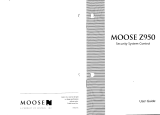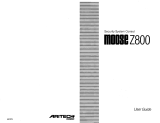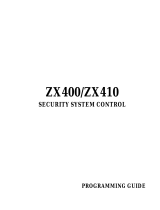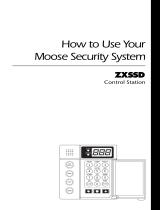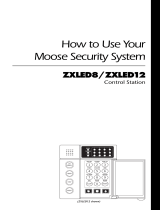Page is loading ...

THESE SYSTEMS HAVE BEEN DISCONTINUED
Table Of Contents Z900 and Z950
1. Operating Your System
1.1 System Orientation . . . . . . . . . . . . . . . . . . . . . . . . . . . . . ..1-1
1.2 Arming . . . . . . . . . . . . . . . . . . . . . . . . . . . . . . . . . . . . . . . . .1-3
Timing The System Prior To Leaving . . . . . . . . . . . . . . . ..1-3
Arming The System Without Leaving . . . . . . . . . . . . . . . . .1-4
Turning Off The Interior Zones and Entrance Delay . . 1-4
Automatic Interior Off/Delay Off . . . . . . . . . . . . . . . . . . 1-5
Two Digit Arming. . . . . . . . . . .. . . . . . . . . . . . . . . . . . . .1-5
System Will Not Arm (READY Light Off). . . . . . . . . . . . . . 1-5
1.3 Disarming . . . . . . . . . . . . . . . . . . . . . . . . . . . . . . . . . . . . .1-6
Disarming Upon Entering The Premises . . . . . . . . . . . . . .1-6
1.4 Alarm Conditions . . . . . . . . . . . . . . . . . . . . . . . . . . . . . . . . . 1-7
What To Do If An Alarm Occurs . . . . . . . . . . . . . . . . . . . . . . .1-7
To reset the alarm: . .. . . . . . . . . . . . . . . . . . . . . . . . . . . .1-7
False Alarms. . . . . . . . . . . . . . . . . . . . . . . . . . . . . . . . . . . . . . 1-7
1.5 The Keypad Panic Alarms . . . . . . . . . . . . . . . . . . . . . . . . . . 1-8
Alarm Activation . . . . . . . . . . . . . . . . . . . . . . . . . . . . . . . . . . . 1-8
Resetting the Alarm . . . . . . . . . . . . . . . . . . . . . . . . . . . . . . . . 1-8
1.6 Special Features . . . . . . . . . . . . . . . . . . . . . . . . . . . . . . . . . .1-9
Chime Mode Operation . . . . . . . . . . . . . . . . . . . . . . . . . . . . . 1-9
To Turn CHIME On . . . . . . . . . . . . . . . . . . . . . . . . . . . . .1-9
To Turn CHIME Off . . . . . . . . . . . . . . . . . . . . . . . . . . . . .1-9
Force Arming. . . . . . . . . . . . . . . . . . . . . . . . . . . . . . . . . . . . . .1-9
Bypassing Zones . . . . . . . . . . . . . . . . . . . . . . . . . . . . . . . . .1-10
To Bypass A Zone. . . . . . . . . . . . . . . . . . . . . . . . . . . . . 1-10
To Cancel A Zone Bypass. . . . . . . . . . . . . . . . . . . . . . .1-10
To Cancel All Zone Bypasses . . . . . . . . . . . . . . . . . . . .1-11
To Bypass All Faulted Zones Simultaneously . . . . . . . .1-11
User Manual i

Key Switch Operation . . . . . . . . . . . . . . . . . . . . . . . . . . . . .1-11
Arming . . . . . . . . . . . . . . . . . . . . . . . . . . . . . . . . . . . .. . 1-11
Disarming . . . . . . . . . . . . . . . . . . . . . . . . . . . . . . . . . . . .1-11
Access . . . . . . . . . . . . . . . . . . . . . . . . . . . . . . . . . . . . . . . 1-12
The Reset Key . . . . . . . . . . . . . . . . . . . . . . . . . . . . . . . . . 1-12
Remote Programming . . . . . . . . . . . . . . . . . . . . . . . . .. . . 1-12
Alarm Memory . . . . . . . . . . . . . . . . . . . . . . . . . . . . . . . . . 1-12
Audible Zone Testing With Bell Test and Dialer Test . . . . 1-13
1.7 Fire Detection . . . . . . . . . . . . . . . . . . . . . . . . . . . . . . . . . . 1-15
What To Do If The Fire Alarm Sounds . . . . . . . . . . . . . . . .1-15
Fire Supervisory/Trouble (Resetting Smoke Detectors) . . 1-16
2. Evacuation Plan
2.1 Developing An Evacuation Plan . . . . . . . . . . . . . . . . . . . . 2-1
2.2 Fire Prevention And Escape. . . . . . . . . . . . . . . . . . . . . . . . 2-2
Know Fire Hazards. . . . . . . . . . . . . . . . . . . . . . . . . . . . . . 2-2
In Case Of Fire . . . . . . . . . . . . . . . . . . . . . . . . . . . . . . . . . . 2-2
Be Prepared . . . . . . . . . . . . . . . . . . . . . . . . . . . . . . . . . . . . 2-3
3. Programming
3.1 User Codes . . . . . . . . . . . . . . . . . . . . . . . . . . . . . . . . . . . . . 3-1
Changing User Codes . . . . . . . . . . . . . . . . . . . . . . . . . . . . .. 3-2
To Change A User Code . . . . . . . . . . . . . . . . . . . . . . . . 3-2
Deleting a Code . . . . . . . . . . . . . . . . . . . . . . . . . . . . . . . . . . 3-3
Programming A Temporary Code (User Code 6 / 8) . . . . . . .3-3
Glossary
Index
ii User's Manual

Operating Your System
1
1.1 System Orientation
NOTE
Your security system may consist of either 8 zones, 8 users
or 6 zones, 6 users. Please verify the number of zones and
users with your Security Company Representative.
The keypad for your security system is illustrated in FIGURE 1-1 on Page 1-2.
The keypad is the most important and most used component in your security
system. It is important that you carefully review the information presented on
Pages 1-1 and 1-2, and become familiar with all features and functions of your
keypad.
The primary components of the keypad are as follows:
* Numeric User keys, Reset (*) key, and Bypass (#) key
The numeric User keys are used to enter your user code when arming
or dis arming the security system. They are also used in
programming the security system.
The Reset (*) key is used to silence the keypad sounder or exit audible
test mode. It cannot reset the alarm or cancel the reporting of an
alarm. See Page 1-12.
The Bypass (#) key is used to bypass selected zones in your security
system. See Page 1-10.
* Ready Status Indicator
The Ready Status Indicator (green), when illuminated, indicates that
your security system is ready to be armed. If the indicator is not
illuminated, one or more protection zones are not ready (faulted) for
arming.
* Armed Status Indicator
The Armed Status Indicator (red), when illuminated, indicates that your
se curity system is armed. If the indicator is not illuminated, your
system is dis armed. If the indicator is blinking, the system has
delayed arming to enable you time to leave the building. After a pre-
programmed exit delay time, the system will fully arm. During the
last 10 seconds of exit delay, the beep accel erates to fast beep,
warning that arming is about to occur.
* Panic Keys
The Panic keys are keys used in specific situations. The function of

each key and its programming are explained on Page 1-8.
User's Manual 1-1



1.2 Arming
Arming The System Prior To Leaving
Before your security system can be armed, all of the intrusion zones
must be secure as indicated by the green READY indicator. If the
READY indicator is off, one or more zones are faulted. The
indicator(s) corresponding to the faulted zone(s) will light. Determine
the areas of protection which are assigned to each of the zones, then
check the appropriate doors and windows to see that they are closed.
1. Verify that the READY indicator is on.
2. Enter your User Code.
3. The keypad will begin beeping and the red ARMED indicator will blink
to indicate that arming will take place after the exit time expires. (The
ARMED indicator will light steady after the system arms).
4. Leave the building immediately.
The control is programmed with an exit delay time which allows a specific
amount of time to leave through any delay defined intrusion detection zone
without causing an alarm. Be sure that you have been informed on routes to
enter and exit from without causing an alarm.
On the Z950/Z880 only, the beeping tone will become more rapid for the last 10
seconds, warning you that arming is about to occur. If the exit door is not
secure during the last 10 seconds of the exit delay, then the exit delay will be
restarted for one full exit delay period. This exit delay restart is only performed
once.
User's Manual
1-3

Arming The System Without Leaving
Your security system is divided into two areas of protection:
1. PERIMETER - The first line of defense. Consists of one or more zones which
detect intrusion through doors and windows.
2. INTERIOR - The backup or second line of defense. Consists of one or more
zones that detect intruders that have already entered the building. Interior
detection devices usually consist of motion detection devices, interior
door contacts, and under carpet sensors, designed to surprise the
intruder.
Prior to arming the control, you may first choose to turn off the interior protection,
allowing free movement within the building when armed.
Turning Off The Interior Zones (Key 4) and Entrance Delay (Key 5)
Key 4 may be used to turn the interior zones off prior to arming.
1. Press the 4 key and hold for three seconds.
2. When interior defined zones are turned off, their corresponding Zone
indicators will flash. They may continue to flash until 30 seconds after
the system is armed or they may flash for the entire time that the system
is armed. The installer can program how the flashing operates.
3. Arm the system by entering your User Code.
NOTE
Upon disarming, the interior zones automatically re-enable unless your
installer has altered this feature through programming.
Key 5 may be used to turn the entrance delay time off. Press the 5 key and hold
for three seconds to turn off the entrance delay. When the delay is turned off, the
armed light will not blink after arming. This will allow the system to alarm instantly
if the entrance door is opened while armed.

1-4 User's Manual

Automatic Interior Off/Delay Off
Your system may have been programmed to automatically turn the
interior zones off if you arm and do not leave the premises before the exit
delay time expires. The entrance delay may also be programmed to
automatically turn off at this time. When the system is disarmed, the
interior and delay will return to their normal on or off state. See your
security company representative for details.
Two Digit Arming
Your system may have been programmed with an abbreviated arming
feature. When this feature is enabled, only the first two digits of your
User Code will be required to arm the system and perform other features.
Disarming however, will still require the entire code sequence.
System Will Not Arm (READY Light Off)
If the READY indicator is off, one or more detection devices such as a
door or window has been left open. The system cannot be armed. One
or more of the ZONE indicators will also be lit indicating the area of
protection that is at fault.
If an attempt is made to arm the system with the READY light off, a
three second error tone will be emitted to alert you that the system did
not arm.
User's Manual 1-5

1.3 Disarming
Disarming Upon Entering The Premises
Your system is programmed with one or more entrance delay zones which allow
time to enter the premises without causing an alarm. Each delay door may have one
of two different entry times. Be sure to check with your installer.
If your system has the "Interior Follower" feature enabled, all interior designated
zones automatically become delay zones whenever you first enter through a delay
zone. This allows you to walk in front of motion detectors on the way to the keypad
after you enter.
1. After entering the premises through a delay zone, the keypad will
sound a continuous tone to remind you to disarm the system.
WARNING
IF THE ALARM INDICATOR IS LIT AND THE KEYPAD IS BEEPING, AN ALARM HAS
OCCURRED. LEAVE THE PREMISES IMMEDIATELY AND GO TO THE NEAREST
PHONE TO CONTACT THE APPROPRIATE AUTHORITIES. DO NOT ENTER THE
PREMISES.
2. Enter your User Code.
3. The red armed light should turn off indicating that the system is
disarmed.

1-6 User's Manual

1.4 Alarm Conditions
What To Do If An Alarm Occurs
Whenever an alarm occurs, the ALARM indicator will light, the audible alarm will
sound (if applicable), and the control will communicate with the Central Station
(if this option was purchased).
WARNING
IF UPON RETURNING TO THE PREMISES, IT IS DISCOVERED THAT AN
ALARM HAS OCCURRED, DO NOT ENTER THE PREMISES. GO TO THE
NEAREST TELEPHONE AND CONTACT THE APPROPRIATE
AUTHORITIES.
To reset the alarm:
1. Enter your User Code to reset the alarm.
2. The ALARM indicator will remain lit.
If the alarm was activated through one of the "hardwire" zones, the corre-
sponding ZONE indicator(s) will also be lit, identifying the specific area that was
violated. If the alarm was activated manually by pressing one of the keys, no
zone indicators will be lit. Press the Reset (*) key to extinguish the ALARM
indicator after determining the type of alarm that occurred and area of protection
involved.
A history of the alarm condition will be stored in the control's memory and may
be recalled at any time. See "Special Features" for more information.
False Alarms
If for any reason a false alarm occurs, perform the following steps:
1. Enter your User Code. The armed light should turn off.
2. Notify the appropriate authorities of the alarm immediately.
3. Press the Reset (*) key to extinguish the ALARM light.

User's Manual 1-7

1.5 The Keypad Panic Alarms
Your system may have been purchased with up to three keypad panic alarms. These
may be used to activate an alarm in the event of a Fire, Hold-up, or other condition,
as programmed by your installer. Each alarm is activated by pressing the
appropriate panic key (located below the numeric keys). Each alarm may be
programmed to report the condition to a central monitoring station. Check with your
security company representative to determine the characteristics of your system.
Alarm Activation
Each of the three panic keys (See FIGURE 1-1) can initiate a specific type of alarm
as programmed and labeled by your installer.
To activate an alarm, press the appropriate panic key and hold for three seconds.
The alarm will activate.
Your installer may have programmed the panic zones to ignore momentary key
presses and to activate only by pressing and holding pressed for three seconds (or
pressing at least twice within three seconds). Check with your security company
representative for the specific characteristics of your system.
Resetting The Alarm
When an Alarm is activated, the ALARM indicator will be lit (unless your installer has
programmed the alarm for silent or no keypad indication).
To reset the alarm, enter your user code. Pressing the Reset (*) key will extinguish
the ALARM indicator, if lit.
A history of the last alarm will be stored in the control's memory and may be recalled
if desired. (See Alarm Memory on page 1-12.)

1-8 User's Manual

1.6 Special Features
Chime Mode Operation
The CHIME mode allows audible monitoring of zones while the system is dis-
armed. When the CHIME mode is active, the keypad sounder will beep when ever
a perimeter burglar defined zone (door, window, etc.) indicator is opened.
For example, the CHIME feature will cause the keypad to beep two times whenev-
er the front door has been opened. Many businesses use this type of signal to
announce that a customer has entered. In a residential application, the CHIME is
useful for monitoring opening of doors by children.
The CHIME feature does not annunciate interior zones.
To Turn CHIME On
I .The system must be disarmed.
2. Press the "6" key and hold for three seconds. The keypad will
beep three times to signify that the CHIME has been turned on.
3. The keypad will now beep two times when any burglar zone is
opened.
To Turn CHIME Off
Press the "6" key and hold for three seconds. The keypad will beep two times to
signify that the CHIME has been turned off.
Force Arming (This feature is disabled in U.L. Listed systems)
Your system may be programmed for quick arming even with one or more zones
faulted. In this condition, when an attempt is made to arm the system with faulted
zones (READY light off), the keypad will emit a three second error tone, indicating
that the system refused to arm. If a second attempt to arm is made within eight
seconds after the tone quits, all faulted zones will automatically be bypassed and the
system will Force Arm. Depending upon how your system was programmed at the
time of installation, force armed zones will either be per-manently bypassed until
disarming or may return to operation when or if they become operable.

User's Manual 1-9

Bypassing Zones
The Bypass (#) key is used to bypass selected zones in your system. A bypassed
zone will NOT be capable of activating an alarm as it is temporarily removed from
your system. Bypassing (also referred to as shunting) is most commonly used to
allow free movement of an area (zone or group of zones) while arming the rest of the
system or to temporarily remove a zone or zones that require service, allowing partial
use of the system until repaired. When a zone is bypassed, its corresponding Zone
indicator will flash to indicate that is has been removed from operation. It may
continue to flash until 30 seconds after the system is armed or it may flash for entire
time that the system is armed. The installer can program how the flashing operates.
WARNING
WHEN ZONES ARE BYPASSED, SECURITY IS COMPROMISED. DO NOT
INSTRUCT TEMPORARY USERS ON USE OF THE BYPASS FEATURE.
To Bypass A Zone
1. The system must be disarmed.
2. Press the Bypass (#) key, then enter the number of the zone to
be bypassed.
3. The corresponding ZONE indicators will blink to indicate the
zones that have been bypassed. The blinking will cease after
the system is armed and the exit delay has expired. If Perma-
nent Force-Arming has been enabled, then the ZONE indica
tors for the bypassed zones will continue to blink during the
ARMED period.
4. Repeat steps 2 and 3 to bypass other zones.
To Cancel A Zone Bypass
1. The system must be disarmed.
2. Press the Bypass (#) key followed by the number of the zone to
be restored to service.
3. The ZONE indicator of the previously bypassed zone will stop
blinking.

1-10 User's Manual
/
